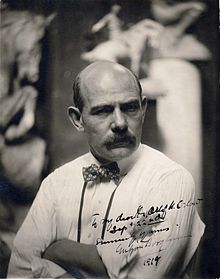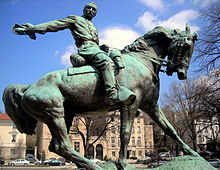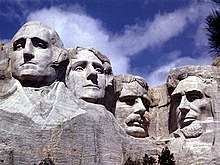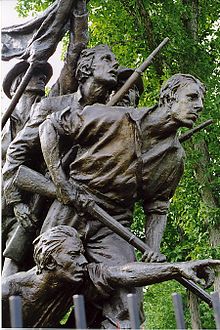EXCEPTIONAL AMERICAN ARTISTS SCULPTORS CIVIL WAR GENERALS MEMORIALS RELIEFS ARTWORKS
PLEASE SEE MY ADDITIONAL LISTINGS FOR MORE EXCEPTIONAL PHOTOGRAPHS.
PLEASE READ THE FOLLOWING CAREFULLY!
ALL NON-USA RESIDENTS: SHIPPING IS $18.00 BY STANDARD INTERNATIONAL MAIL FOR FLAT ENVELOPES ONLY. PACKAGE POSTAL FEES ARE DETERMINED BY THE PACKAGE'S SIZE AND WEIGHT. PLEASE KNOW A CUSTOMS DECLARATION IS REQUIRED ON ALL INTERNATIONAL PACKAGES. INSURED PACKAGES MUST BE SENT PARCEL POST AND THE FEE IS $50.00 PLUS THE INSURANCE FEE. WINNING BIDDERS ACCEPT ALL SHIPPING RISKS FOR UNINSURED INTERNATIONAL PACKAGES. WINNING BIDDERS WILL RECEIVE AN EBAY INVOICE OR PERSONAL EMAIL FROM ME AFTER THE AUCTION CLOSES REGARDING PAYMENT AND SHIPPING DETAILS. PLEASE NOTE THAT I AM OBLIGATED UNDER U. S. LAW TO DECLARE THE FULL VALUE OF A PACKAGE SHIPPED OUT OF THE UNITED STATES. PLEASE DO NOT ASK ME TO BREAK THE LAW AND DO OTHERWISE.
ALL USA RESIDENTS: PAYMENT MUST BE MADE WITHIN THREE DAYS BY PAYPAL. ANY OTHER ARRANGEMENTS MUST BE MADE WITH ME WELL IN ADVANCE! NO EXCEPTIONS! CONNECTICUT RESIDENTS ARE SUBJECT TO 6.35% SALES TAX. UNLESS OTHERWISE STATED SHIPPING IS $ 9.00 IN THE UNITED STATES BY PRIORITY MAIL WITH DELIVERY CONFIRMATION. I CAN COMBINE SHIPPING ON MULTIPLE PURCHASES CLOSING THE SAME WEEK.
FOR COMBINED SHIPPING, YOU MUST WAIT FOR MY INVOICE!!!
Memorial Carving
The largest high relief sculpture in the world, the Confederate Memorial Carving, depicts three Confederate figures of the Civil War, President Jefferson Davis and Generals Robert E. Lee and Thomas J. "Stonewall" Jackson. The entire carved surface measures three-acres, larger than a football field and Mount Rushmore. The carving of the three men towers 400 feet above the ground, measures 90 by 190 feet, and is recessed 42 feet into the mountain. The deepest point of the carving is at Lee's elbow, which is 12 feet to the mountain's surface.
In 1912 the carving existed only in the imagination of Mrs. C. Helen Plane, charter member of the United Daughters of the Confederacy (UDC). The Venable family, owners of the mountain, deeded the north face of the mountain to the UDC in 1916. The UDC was given 12 years to complete a sizable Civil War monument.
Three sculptors worked on the carving during its creation. Gutzon Borglum was hired in 1915 as the carving consultant, and in 1916 he was appointed carving sculptor by the Stone Mountain Monumental Association. Borglum envisioned a carving with seven central figures accompanied by "an army of thousands." He was not able to begin work on the carving until 1923 due to funding problems and World War I.
After blasting away large portions of the mountain with dynamite, Borglum was able to complete the head of Lee on January 19, 1924. In 1925 a dispute arose between Borglum and the managing association. As a result of the conflict, Borglum left, taking all of his sketches and models with him. Borglum went on to carve the famous Mount Rushmore sculpture in South Dakota.
Augustus Lukeman, the second sculptor, resumed work on the project in 1925. Lukeman's carving included the three central figures of the Confederacy on horseback. He removed Borglum's work from the mountain and diligently worked with pneumatic drills, but by 1928 (the original deadline) only Lee's head was complete and funds were depleted. The Venable family reclaimed their property, and the massive granite mountain remained untouched for 36 years.
In 1958 the state of Georgia purchased the mountain and the surrounding land. The Georgia General Assembly created the Stone Mountain Memorial Association. In 1960 the Stone Mountain Confederate Memorial Advisory Committee was comprised of six internationally known figures in the world of art. A competition was held, and nine world-renowned sculptors submitted designs for a new sculpture.
In 1963, based upon recommendations by the Advisory Committee, the Stone Mountain Memorial Association chose Walker Kirkland Hancock of Gloucester, Massachusetts to complete the carving. Work resumed in 1964, and a new technique utilizing thermo-jet torches was used to carve away the granite. Chief carver Roy Faulkner, a marine veteran with a talent for using the new thermo-jet torch, was able to remove tons of stone in one day. For over eight years Park guests could see and hear the workmen and their jet torches.
The figures were completed with the detail of a fine painting. Eyebrows, fingers, buckles and even strands of hair were fine-carved with a small thermo-jet torch.
The carving is actually much larger than it appears from Stone Mountain Park's attractions. Workers could easily stand on a horse's ear or inside a horse's mouth to escape a sudden rain shower. A dedication ceremony for the Confederate Memorial Carving was held on May 9, 1970. Finishing touches were completed in 1972.
Gutzon Borglum
Gutzon Borglum | |
|---|---|
 Borglum, 1919 | |
| Born | John Gutzon de la Mothe Borglum March 25, 1867 |
| Died | March 6, 1941 (aged 73) |
| Resting place | Forest Lawn Memorial Park, Glendale, California |
| Nationality | American |
| Education | Mark Hopkins Institute of Art[1][2] Académie Julian[3] École des Beaux-Arts[2] California School of Design[4] |
| Known for | Sculpture, painting |
| Movement | Bull Moose Party[5] |
John Gutzon de la Mothe Borglum (March 25, 1867 – March 6, 1941) was an American sculptor best known for his work on Mount Rushmore. He is also associated with various other public works of art across the U.S., including Stone Mountainin Georgia, the statue of Union General Philip Sheridan in Washington, D.C., as well as a bust of Abraham Lincoln which was exhibited in the White House by Theodore Roosevelt[6] and which is now held in the United States Capitol crypt in Washington, D.C.[7]
Early life[edit]
The son of Danish immigrants, Gutzon Borglum was born in 1867 in St. Charles in what was then Idaho Territory. Borglum was a child of Mormon polygamy. His father, Jens Møller Haugaard Børglum (1839–1909), came from the village of Børglum in northwestern Denmark. He had two wives when he lived in Idaho: Gutzon's mother, Christina Mikkelsen Børglum (1847–1871), and her sister Ida, who was Jens's first wife.[8] Jens Borglum decided to leave Mormonism and moved to Omaha, Nebraska where polygamy was both illegal and taboo.[9] Jens Borglum worked mainly as a woodcarver before leaving Idaho to attend the Saint Louis Homeopathic Medical College[10] in St. Louis, Missouri. At this point "Jens and Christina divorced, the family left the Mormon church, and Jens, Ida, their children, and Christina's two sons, Gutzon and Solon, moved to St. Louis, where Jens earned a medical degree. (Jens) then moved the family to Nebraska, where he became a county doctor".[11][12] Upon his graduation from the Missouri Medical College in 1874, Dr. Borglum moved the family[11] to Fremont, Nebraska, where he established a medical practice. Gutzon Borglum remained in Fremont until 1882, when his father enrolled him in St. Mary's College, Kansas.[13]
After a brief stint at Saint Mary's College, Gutzon Borglum moved to Omaha, Nebraska, where he apprenticed in a machine shop and graduated from Creighton Preparatory School.
New York City[edit]
Back in the U.S. in New York City, he sculpted saints and apostles for the new Cathedral of St. John the Divine in 1901; in 1906 he had a group sculpture accepted by the Metropolitan Museum of Art[14]— the first sculpture by a living American the museum had ever purchased—and made his presence further felt with some portraits. He also won the Logan Medal of the Arts. His reputation soon surpassed that of his younger brother Solon Borglum, already an established sculptor.
Family[edit]
Borglum married Mary Montgomery Williams, on May 20, 1909, with whom he had three children,[8] including a son, Lincoln, and a daughter, Mary Ellis (Mel) Borglum Vhay (1916–2002).
Public life[edit]
Borglum was active in the committee that organized the New York Armory Show of 1913, the birthplace of modernism in American art. By the time the show was ready to open, however, Borglum had resigned from the committee, feeling that the emphasis on avant-garde works had co-opted the original premise of the show and made traditional artists like himself look provincial. He moved into an estate in Stamford, Connecticut[15] in 1914 and lived there for 10 years. He sheltered Czechoslovak Legion members on his land at Stamford in 1917.[16]
Borglum was an active member of the Ancient Free and Accepted Masons (the Freemasons), raised in Howard Lodge #35, New York City, on June 10, 1904, and serving as its Worshipful Master 1910–11. In 1915, he was appointed Grand Representative of the Grand Lodge of Denmark near the Grand Lodge of New York. He received his Scottish Rite Degrees in the New York City Consistory on October 25, 1907.[17] He was friends with Theodore Roosevelt for many years[18][19] and during the 1912 United States presidential election Borglum was a very active campaign organizer and member[20] of the Bull Moose Party.[21][22]
While it has been claimed that Borglum was a member of the Ku Klux Klan,[23] an article in the Smithsonian Magazine denies that there is proof that he officially joined the KKK.[24] That said, he became "deeply involved in Klan politics", attending Klan rallies and serving on Klan committees.[25] In 1925, having only completed the head of Robert E. Lee, Borglum was dismissed from the Stone Mountain project, with some holding that it came about due to infighting within the KKK, with Borglum involved in the strife.[26] Later, he stated "I am not a member of the Kloncilium, nor a knight of the KKK," but Howard Shaff and Audrey Karl Shaff claim that "that was for public consumption."[27] The museum at Mount Rushmore displays a letter to Borglum from D. C. Stephenson, the infamous Klan Grand Dragon who later was convicted of the rape and murder of Madge Oberholtzer. The 8x10 foot portrait contains the inscription "To my good friend Gutzon Borglum, with the greatest respect." Correspondence from Borglum to Stephenson during the 1920s detailed a deep racist conviction in Nordic moral superiority and strict immigration policies.[28]
Monuments[edit]
A fascination with gigantic scale and themes of heroic nationalism suited his extroverted personality. His head of Abraham Lincoln, carved from a six-ton block of marble, was exhibited in Theodore Roosevelt's White House and can be found in the United States Capitol Crypt in Washington, D.C. A "patriot," believing that the "monuments we have built are not our own," he looked to create art that was "American, drawn from American sources, memorializing American achievement," according to a 1908 interview.[citation needed] Borglum was highly suited to the competitive environment surrounding the contracts for public buildings and monuments, and his public sculptures are found all around the United States.
In 1908, Borglum won a competition for an equestrian statue of the Civil War General Philip Sheridan to be placed in Sheridan Circle in Washington, D.C. A second version of General Philip Sheridan was erected in Chicago, Illinois, in 1923. Winning this competition was a personal triumph for him because he won out over sculptor J.Q.A. Ward, a much older and more established artist and one whom Borglum had clashed with earlier in regard to the National Sculpture Society. At the unveiling of the Sheridan statue, one observer, President Theodore Roosevelt (whom Borglum was later to include in the Mount Rushmore portrait group), declared that it was "first rate"; a critic wrote that "as a sculptor Gutzon Borglum was no longer a rumor, he was a fact." (Smith:see References)[full citation needed]
President Franklin D. Roosevelt delivered an address on May 3, 1934 dedicating a statue of William Jennings Bryan created by Borglum. This Bryan statue by Borglum originally stood in Washington, D.C. but was displaced by highway construction moved by an Act of Congress in 1961 to Salem, Illinois, Bryan's birthplace.[29][30]
In 1925, the sculptor moved to Texas to work on the monument to trail drivers commissioned by the Trail Drivers Association. He completed the model in 1925, but due to lack of funds it was not cast until 1940, and then was only a fourth its originally planned size. It stands in front of the Texas Pioneer and Trail Drivers Memorial Hall next to the Witte Museum in San Antonio. Borglum lived at the historic Menger Hotel, which in the 1920s was the residence of a number of artists. He subsequently planned the redevelopment of the Corpus Christi waterfront; the plan failed,[why?] although a model for a statue of Christ intended for it was later modified by his son and erected on a mountaintop in South Dakota. While living and working in Texas, Borglum took an interest in local beautification. He promoted change and modernity, although he was berated by academicians.[31]
Stone Mountain[edit]
Borglum was initially involved in the carving of Stone Mountain in Georgia. Borglum's nativist stances made him seem an ideologically sympathetic choice to carve a memorial to heroes of the Confederate States of America, planned for Stone Mountain, Georgia. In 1915, coinciding with the Klan-glorifying, highly successful The Birth of a Nation, he was approached by the United Daughters of the Confederacy with a project for sculpting a 20-foot (6 m) high bust of General Robert E. Lee on the mountain's 800-foot (240 m) rockface. Borglum accepted, but told the committee, "Ladies, a twenty-foot head of Lee on that mountainside would look like a postage stamp on a barn door."[32]
Borglum's ideas eventually evolved into a high-relief frieze of Lee, Jefferson Davis, and Stonewall Jackson riding around the mountain, followed by a legion of artillery troops. Borglum agreed to include a Ku Klux Klan altar in his plans for the memorial to acknowledge a request of Helen Plane in 1915, who wrote to him: "I feel it is due to the KKK that saved us from Negro domination and carpetbag rule, that it be immortalized on Stone Mountain".[26]
After a delay caused by World War I, Borglum and the newly chartered Stone Mountain Confederate Monumental Association set to work on this monument, the largest ever attempted. Many difficulties slowed progress, some because of the sheer scale involved. After finishing the detailed model of the carving, Borglum was unable to trace the figures onto the massive area on which he was working, until he developed a gigantic magic lantern to project the image onto the side of the mountain.
Carving officially began on June 23, 1923, with Borglum making the first cut. At Stone Mountain he developed sympathetic connections with the reorganized Ku Klux Klan, who were major financial backers of the monument. Lee's head was unveiled on Lee's birthday January 19, 1924, to a large crowd, but soon thereafter Borglum was increasingly at odds with the officials of the organization. His domineering, perfectionist, authoritarian manner brought tensions to such a point that in March 1925 Borglum smashed his clay and plaster models. He left Georgia permanently, his tenure with the organization over. None of his work remains, as it was all blasted off the mountain's face for the work of Borglum's replacement Henry Augustus Lukeman. In his abortive attempt, however, Borglum had developed the necessary techniques for sculpting on a gigantic scale that made Mount Rushmore possible.[33]
Mount Rushmore[edit]
His Mount Rushmore project, 1927–1941, was the brainchild of South Dakota state historian Doane Robinson.[34] His first attempt with the face of Thomas Jefferson had to be redone when it was determined that there was not enough stone to complete it.[35] Dynamite was used to remove large areas of rock from under Washington's brow. The initial pair of presidents, George Washington and Thomas Jefferson, was soon joined by Abraham Lincoln and Theodore Roosevelt.[36]
Ivan Houser, father of John Sherrill Houser, was assistant sculptor to Gutzon Borglum in the early years of carving; he began working with Borglum shortly after the inception of the monument and was with Borglum for a total of seven years. When Houser left Gutzon to devote his talents to his own work, Gutzon's son, Lincoln, took over as Assistant-Sculptor to his father.[37]
Borglum alternated exhausting on-site supervising with world tours, raising money, polishing his personal legend, sculpting a Thomas Paine memorial for Paris and a Woodrow Wilson memorial for Poznań, Poland (1931).[38] In his absence, work at Mount Rushmore was overseen by Bill Tallman[39] and later his son, Lincoln Borglum.[40] During the Rushmore project, father and son were residents of Beeville, Texas. When he died in Chicago, following complications of surgery, his son finished another season at Rushmore, but left the monument largely in the state of completion it had reached under his father's direction.[41]
Other works[edit]
In 1909, the sculpture Rabboni was created as a grave site for the Ffoulke Family in Washington, D.C. at Rock Creek Cemetery.[42]
Four public works by Borglum are in Newark, New Jersey: Seated Lincoln (1911), Indian and the Puritan (1916), Wars of America (1926), and a stele with bas-relief, First Landing Party of the Founders of Newark (1916).[43][44]
In 1912, the Nathaniel Wheeler Memorial Fountain was dedicated in Bridgeport, Connecticut.
Memorial to Robert Louis Stevenson at Baker Cottage, Saranac Lake, New York. Unveiled in 1915.
In 1918, he was one of the drafters of the Czechoslovak declaration of independence.[45]
One of Borglum's more unusual pieces is the Aviator completed in 1919 as a memorial for James Rogers McConnell, who was killed in World War I while flying for the Lafayette Escadrille. It is located on the grounds of the University of Virginia in Charlottesville, Virginia.[46]
In 1922, he crafted a sculpture of William D. Hoard in what is now the Henry Mall Historic District on the campus of the University of Wisconsin.[citation needed]
His statue of Collis P. Huntington was completed in 1924 and stands at the entrance of the CSX Huntington headquarters building located in the 900 block of Seventh Avenue Huntington, West Virginia.
His statue of Harvey W. Scott was completed in 1933 and stood at the peak of Mount Tabor, Portland, Oregon until it was toppled by protestors in 2020.
Borglum sculpted the memorial Start Westward of the United States, which is located in Marietta, Ohio (1938).[47]
He built the statue of Daniel Butterfield at Sakura Park in Manhattan (1918).[48]
He created a memorial to Sacco and Vanzetti (1928), a plaster cast of which is now in the Boston Public Library.[49][50][51][52][53]
Another Borglum design is the North Carolina Monument on Seminary Ridge at the Gettysburg Battlefield in south-central Pennsylvania. The cast bronze sculpture depicts a wounded Confederate officer encouraging his men to push forward during Pickett's Charge. Borglum had also made arrangements for an airplane to fly over the monument during the dedication ceremony on July 3, 1929. During the sculpture's unveiling, the plane scattered roses across the field as a salute to those North Carolinians who had fought and died at Gettysburg.[citation needed]
In 1939 when German troops marched into Poland they destroyed Borglum's statue of Woodrow Wilson located in Poznań.[54]
Death[edit]
Borglum died in 1941 of a heart attack and is interred at Forest Lawn Memorial Park in Glendale, California.[55]





